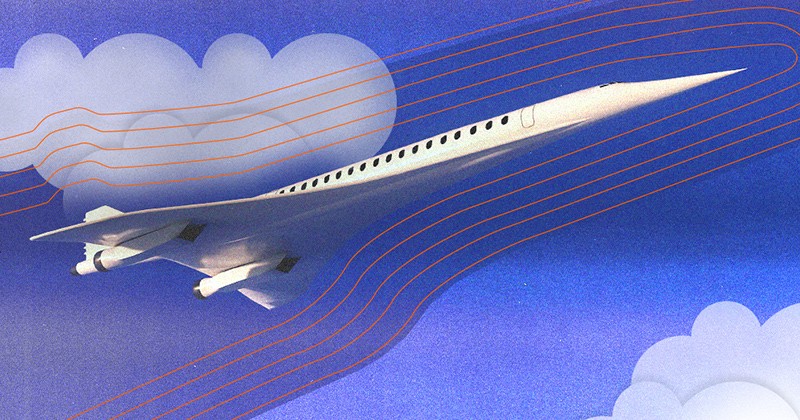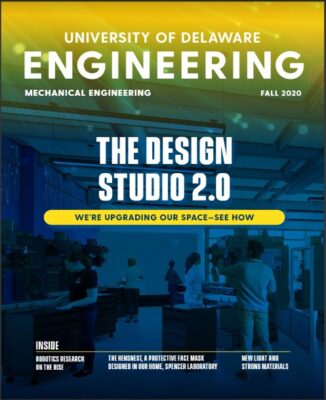UD Professor Joe Kuehl seeks solutions to hypersonic travel challenges
Imagine heading to the Philadelphia International Airport, hopping on a plane and landing in London 45 minutes later. In theory, this kind of high-speed hypersonic travel is possible. In reality, scientists are still grappling with the challenge of how hot vehicles get and how to maintain flight stability when they move that fast.
In a search for solutions, University of Delaware Associate Professor Joseph Kuehl with the University of Delaware’s Department of Mechanical Engineering is partnering with Thomas Juliano, an associate professor of aerospace and mechanical engineering at the University of Notre Dame, to find ways to control turbulence and temperature during hypersonic travel. Their work has gained the support of the Air Force Office of Scientific Research (AFOSR), which has awarded the cross-collegiate team $973,636 to develop the computational research and run the experiments to validate their findings.

Joseph Kuehl is an associate professor with the University of Delaware’s Department of Mechanical Engineering.
This latest award is on top of $800,000 in funding that Kuehl — the only professor at UD focusing on hypersonics research — has received for hypersonics-related research.
Kuehl will fine-tune the computations and theory while Juliano will handle the applied research through experimentation in the AFOSR–Notre Dame Large Mach-6 Quiet Tunnel.
“Having experimental data by which to validate your numerical simulations is super important,” said Ajay Prasad, chair of the Department of Mechanical Engineering at UD’s College of Engineering. “The beauty is, once you validate your numerical code, you can then run many different scenarios literally by a few keystrokes on your computer. The marriage of computer simulations with experimental data is a union that is incredibly powerful.”
If Kuehl’s aerodynamics-based calculations are successfully applied in the wind tunnel experiments, it could have wide-ranging implications for hypersonics research and development far beyond commercial flights. In military applications, being able to travel faster than everyone else offers a strategic advantage, but this work could also improve space travel, shipping and commerce and more.
“The impact of Dr. Kuehl’s work is like a stepping stone toward truly high speed global travel,” Prasad said. “The difficulty with these types of high-speed aircraft is controlling them. To do that, you have to understand the underlying instabilities to gain insights about eventually controlling them. He’s aimed at doing that in a theoretical manner.”

The AFOSR–Notre Dame Large Mach-6 Quiet Tunnel is still in development and the hypersonics travel project underway between the University of Delaware’s Joseph Kuehl and Notre Dame’s Thomas Juliano will help fine tune the high-tech piece of equipment.
Kuehl’s research has focused on something called a “boundary layer,” which is the thin layer of air or atmosphere around a vehicle. He studies how the boundary layer changes from a laminar, or smooth, flow, to a turbulent flow, which exhibits eddies and other unsteady motions. More specifically, he studies how small disturbances grow into turbulence.
The more stable laminar boundary causes about five to 10 times less heating than the turbulent boundary layer. Consider, for example, what happens when a space shuttle enters the atmosphere: intense flames (which are actually a plasma of dissociated air) are often seen at such high temperatures that cause heat shielding to begin to degrade..
“We’re trying to delay that turbulence so that high heat loads occur farther back on the vehicle, if it’s anywhere,” Kuehl said. “That way, the heating is distributed over a larger area.”

The AFOSR–Notre Dame Large Mach 6 quiet hypersonic test facility, shown here, will help test the computations and theories regarding outstanding challenges of hypersonic travel during a project between the University of Delaware’s Joseph Kuehl and Notre Dame’s Thomas Juliano.
High temperatures aren’t the only challenge to high-speed travel. In some cases, the boundary layer doesn’t transition evenly, which means that one half of the vehicle could be impacted by the smooth, laminar layer, while the other half is impacted by the more friction-causing turbulent layer.
“If there’s more friction on one part, that can cause a huge torque and cause you to lose flight stability,” Kuehl said. That can cause a loss of steering ability and ultimately result in a crash — which is known to happen in test flights of hypersonic vehicles in development.
His working theories consider how to influence the temperature of the wall to combat those instabilities.
“Think about a wing of an airplane,” he said. “It would be like wrapping heating blankets around certain sections. That way you can control some of the instabilities we’re concerned about. By imposing temperature variations in a clever way, you can influence this transition to turbulence.”
Or, the idea could be the opposite: Applying cooling strips to certain parts of a vehicle to offset overheating.
By studying the disturbances that lead to turbulence on simple geometries like cones, Kuehl’s work is also helping Notre Dame improve the design of their relatively new hypersonic wind tunnel, which is the largest of its kind in use by any academic institution in the nation.

Thomas Juliano is an associate professor of aerospace and mechanical engineering at the University of Notre Dame.
For the last several years, Juliano and experts at Notre Dame have been fine-tuning and debugging the relatively new hypersonic wind tunnel, which will be unique due to its combination of speed, size and flow quality.
The testing capabilities of the tunnel could help researchers figure out how to fly faster and for longer durations of time, if only they can solve the problems faced when traveling five or more times the speed of sound.
“To design a successful vehicle, we need to be able to predict that heating rate before we design and build and fly the thing,” he said. “So wind tunnels are important tools for getting those predictions.”
Working alongside computational codes like those written by Kuehl will help these researchers (and others) better understand the challenging flow phenomena of high-speed travel.
For now, mainly the vehicles flying at such high speeds are returning from orbit in space. In the early days, scientists just wanted to not burn up on reentry. Now, it’s more about extending the range of those vehicles — but the unique challenges of boundary layer transition still stands in the way.
“The community is getting better at predicting transition, and Prof. Kuehl certainly is one of the people contributing to that,” Juliano said. “And it is exciting that the next big step forward is going to be the ability to control transition.”
Article by Maddy Lauria | Photos by Kathy F. Atkinson and courtesy of the University of Notre Dame | Illustration by Joy Smoker | October 27, 2022


